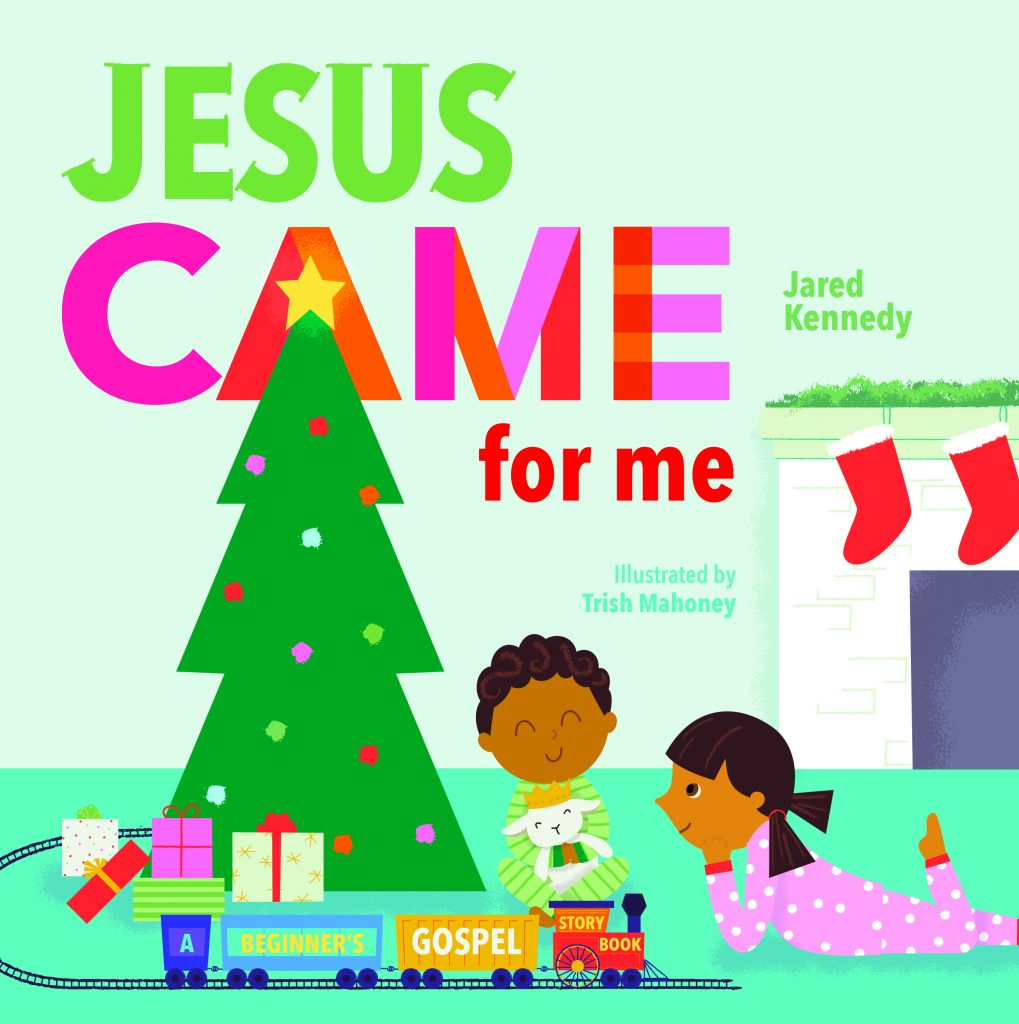Bright lights, cookies, presents, and Santa Claus. That’s usually what young children think of when it comes to Christmas. However, it’s important for them to learn what we really celebrate each December 25th.
Jared Kennedy helps parents teach them just that with Jesus Came for Me: The True Story of Christmas. In this interview, Jared shares some tips for introducing the Christmas story to the youngest members of the family at their age level and why it’s ok to keep the fun traditions of the season as well.
Q: What’s the best way to communicate the message of Christmas to your toddler?
I can’t emphasize enough how important it is just to read and tell the story. According to child psychologists, a “narrative” function emerges in children by age three. That’s just science recognizing the truth that God made the human brain so that we think in stories. Preschoolers are definitely able to grasp the basic plotline of a good story, and from a young age, toddlers also begin to tell stories about their daily lives. As they grow, kids begin to make up even more stories about themselves—about their toys and about imaginative adventures they’re going on. Hearing and telling stories give kids a sense of rooted identity.
But another big thing is creating family traditions that help you tell that story well. That can be as simple as a bedtime routine or something special you do together as a family at Christmas. Our family will read our Christmas devotional, then ride around local neighborhoods looking at Christmas lights. When our preschoolers were buckled into car seats, those drives were short. As they grew older, we added a stop at a coffee shop for a cup of hot chocolate. And our kids remind us to keep up this tradition year after year even now that they’ve become teenagers.
Q: Jesus Came for Me sets out to teach toddlers and preschoolers about the true story of Christmas. How much are children that young able to grasp the importance of Jesus as the promised Savior?
You know, toddlers and young preschoolers are learning by rote and by recognition. Here’s what I mean by that—little kids are learning to repeat back stories, verses, and biblical truth. Sometimes they do that without a whole lot of thought about what the words and stories mean. But those basic concepts are foundational, and learning these truths is essential for kids if they’re going to grow up to have a more mature faith later in life.
Think about this for a moment. Two-year-olds typically have a 200-word vocabulary while three-year-olds have a 1,500-word vocabulary. That’s 1,300 words in a year! Even if we’re faithfully learning the “word of the day” along with Alexa, adults might only learn 350 or so new words in a year. But our youngest kids are learning so many brand-new truths! So, when you read to your preschooler about basic Bible concepts—God’s promise, Jesus being both God and man, his miraculous birth and the angels’ announcement, or even the word “Christmas”—they’re learning those words and their significance for the first time. Later on, preschoolers will be able to recognize biblical concepts that have been taught before. By God’s grace, they’ll spend their whole lives learning to trust the God those stories point them to.
Q: Do you begin the retelling of the story on the night of his birth or do you tell more leading up and following his actual birth?
The board book begins with the announcement of John the Baptist’s birth to Zechariah and ends with the visit of the wise men.
Q: How do you interject thoughts and questions into the book to make the Bible story more personal to the little readers?
Each of the three stories that make up the book is accompanied by brightly colored illustrations by Trish Mahoney that both highlight the story and add fun interactive elements to keep even the youngest child’s attention. Each of the stories also ends with a question that parents and caregivers can use to further reinforce a key truth such as: “Have you ever had a wait a long time? Will you share the good news like the shepherds?”
I’d encourage parents to read the book slowly, to point out the facial expressions on the people’s faces and talk with their children about how each person in the story reacted to the events of Christmas. Point out how the birth of Jesus in a Bethlehem stable and the announcement to poor shepherds isn’t what we’d expect when a king is born.
Q: So much of Christmas in our culture revolves around gifts, decorations, and Santa Claus. Is there anything wrong with participating in all those aspects of the holiday season? How do you connect the dots between those things and the true meaning of Christmas for Christians?
There’s no way around it, pretty much every kid in America is going to know about Santa Claus. Thanks to Coca-Cola, the Macy’s Thanksgiving Day parade, and Bass Pro shops everywhere, the jolly ole’ man in red is a cultural Christmas staple who probably isn’t going away any time soon. Honestly, I think it’s fine to enjoy the Chipmunks Christmas album and Gene Autry—those were the hits in my house growing up—and enjoy other holiday songs too. It’s okay for your kids to experience joyful aspects of our culture. In fact, those can be great connecting points with neighbors who don’t know Jesus. But we must remember that it is our job to teach kids about the true meaning of Christmas—about Jesus’s incarnation and birth as a baby in Bethlehem. As I’ve already said, I think it’s important to make sure telling the true Christmas story is a tradition in your home, and the main emphasis in your Christmas celebration. There are all kinds of ways to do that: making a birthday cake for Jesus, using an Advent devotional, or just reading the story again and again.
There are two things I’d encourage you to keep in mind. First, recognize that we live in a very materialistic world, so work into your schedule some traditions of giving to others without expecting anything in return. Maybe that’s just baking a pan of cookies for the neighbors. Second, I think we need to remind kids from a young age that Christ’s love isn’t earned. Jesus came as God’s free gift. Whether it’s Santa’s naughty list or Elf on the Shelf, there can be a real emphasis in our culture on behaving well in order to get gifts as a reward. But the truth is that Santa is not our judge. If he really was making a list, there are days when all of us would be taken off the “nice” list. Deep down, we’re all still sinful in our hearts.
Jesus, being born of a virgin in a little manger in Bethlehem, was the only person who made it onto God’s “nice” list. And we have hope because, through faith in him, God has made it possible for us to be added to that list as well! He sees us in all our sin, but he still gives us his good and perfect gifts.
Q: Does your family have any special traditions at Christmas that center around Jesus?
We do. Each year, we use a Jesse Tree to tell the Christmas story. In our home, the Jesse Tree is a tiny one-and-a-half-foot discount store Christmas tree. On it, we hang a laminated paper ornament for each day of Advent. Each ornament on the tree represents the story of a person in Jesus’s family tree. The idea of using a Jesse Tree to celebrate Advent comes from Isaiah 11:1 which says, “A shoot shall come out from the stump of Jesse, and a branch shall grow out of his roots.” Jesse was the father of David, Israel’s greatest king. And it was from David’s lineage that Jesus came. Before each symbol is hung on the tree, we read a Bible passage or a story from the Bible.






